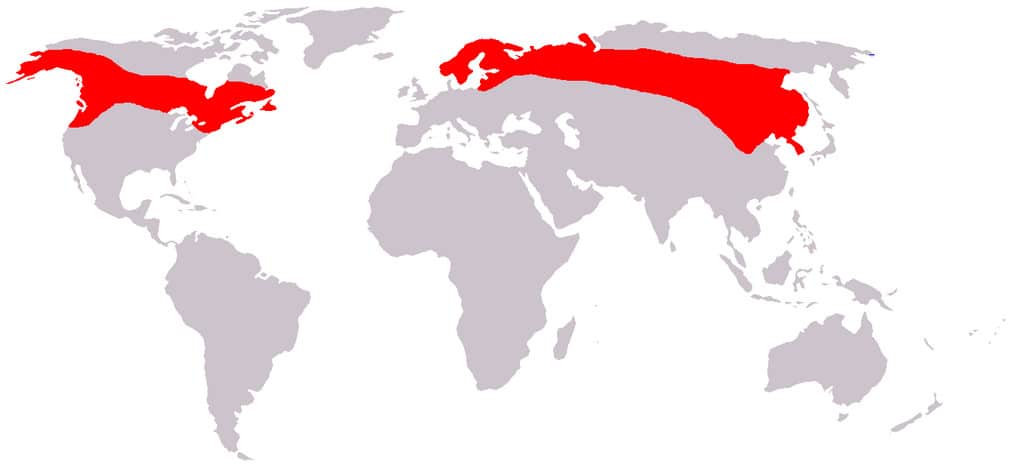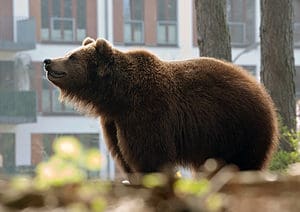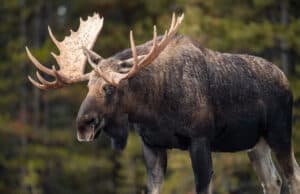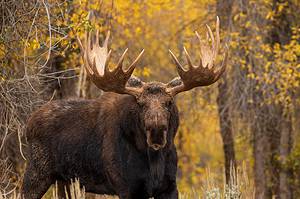If you want to understand the range of moose in North America, you have to head north. That is, assuming you live in southern states or south of Montana. As the largest of the deer family, moose prefer a cooler clime, with the highest population in Maine (within the continental United States).
A typical moose stands up to 7 feet in height and weighs up to 1,100 lbs (male) and 830 lbs (female). Herbivorous and huge, moose require a lot of food to sustain themselves. For the most part, they consume the small sticks and leaves of trees, including ash, maple, birch, and willow, though many others will do as well.
Moose are far from cumbersome and, despite their size, are majestic animals with distinctive and unique characteristics and personalities. Those who live in the southern half of the United States are absent the opportunity to spot one of these incredible animals. Unfortunately, south of Utah and Nebraska is a no-go for either bulls or cows.
What’s The Range Of Moose In North America?

The range of moose in North America covers most of the northern states and Canada. There are also moose in Northern Europe and throughout Asia.
©Jürgen Gbruiker / User:Jrockley, CC BY-SA 3.0 , via Wikimedia Commons – Original / License
The range of moose in North America stretches from the northern regions of Canada, west through Alaska, southeast through the New England States, and south as far as Colorado. Though they are seen in states like Utah and Nebraska, it’s rarer to spot them that far south.
Moose also have preferences according to their gender. Males (bulls) prefer altitude, such as the Rockies and mountainous regions throughout Canada and Alaska. Females (cows) prefer lower altitude areas and are more frequently farther south than bulls.
Bulls are more willing to exchange an abundance of food for a colder climate, with the cows choosing the exact opposite. In higher altitude areas, the available food is more scarce, though the bulls are willing to risk it, seeking out cooler temperatures.
Females prefer the abundance of food and resources, which makes sense for those who are calving. However, cows are far from ignorant of the trade-off. After all, a higher abundance of food and resources also means a higher abundance of predators. Sometimes, cows simply have to choose to go the bull’s way and find altitude or stick with the extra food for their calves.
Range Of Moose In North America By State
In the lower 48, Maine is the hot spot for moose traffic, with roughly 60,000 moose. That’s a lot of moose for the 39th-largest state in the country. Next up, in the lower 48, is Idaho. While it’s reasonable to assume that out of all the New England States below Maine, one would come in second.
However, not only is Idaho second, it’s a very distant second, with a moose population of around 10,000. When it comes to states with the largest moose population, Alaska rules the roost, and it does so by a huge margin. There are roughly 175,000 moose in The Last Frontier, easily more than double the moose population of Maine.
Of course, Alaska isn’t part of the lower 48 and has more in common with the topography and climate of mid-northern Canada than anywhere else. In other words, it’s the perfect home for moose. Coupled with the fact that humans only inhabit 1/20 of 1% of the entire state, it makes it the ideal home for moose. Not to mention every other form of life that’s capable of tolerating the cold weather and interesting night and day dynamics.
As far as the other states that moose inhabit, the numbers drop significantly once you remove Alaska, Maine, and Idaho from the equation.
- Colorado: 3,000
- Minnesota: 4,700
- New Hampshire: 3,300
- Utah: 2,500
- Washington: 5,000
- Wyoming: 3,500
- Vermont: 3,000
Moose are not common in some of the states surrounding the above list, but they are sighted, from time to time, in Nebraska. According to the Lincoln Journal Star, moose sightings, though uncommon, are a part of Nebraska’s history, starting in the 1970s.
Why Moose Stay In The North

Bull moose are far more aggressive throughout the rut.
©Keiki/Shutterstock.com
There are large, thick black bears with plenty of fur in the south, even as far south as Florida. Given the range of moose in North America, why do they never migrate south? As it turns out, even though a black bear stays pretty warm under all that thick skin and fur, it’s just too much for the likes of a moose.
Moose are thick, huge, and have heavily insulating fur. There’s probably a degree of Bergmann’s Rule in there somewhere as well. Bergmann’s Rule primarily focuses on the interesting dynamic of species’ size as it relates to their distance from the equator.
However, when applying Bergmann’s Rule, it’s always an animal that lives both in southern climes and northern climes. For instance, white-tail deer in north Florida are, on average, smaller than white-tail deer in southern Minnesota. Since there are no moose in the southern states, it’s difficult to apply Bergmann’s Rule except to say that northern animals are almost always bigger.
There’s no denying the gargantuan size of a moose and, although no moose live in the south, other deer within the family do. Of course, all of them are much smaller. Moose are also armed with powerful weapons to deal with the larger predators of the north.
For males, the obvious weapon is their gigantic rack, which reaches up to 6 feet in width (from tip to tip) and weighs up to 40 lbs. Just because cows don’t have antlers doesn’t mean they are defenseless either. A cow moose is highly aggressive, especially when calving, and is capable of kicking so hard that bones give way beneath the blows.
Not only are moose well suited for a northern climate, but they are also well-armed.
Final Thoughts
The range of moose in North America is quite extensive. However, this range only includes the northern states, sometimes stretching down into Utah, Colorado, and even Nebraska. Moose prefer it that way. They are well-suited to the climate and seasonal changes. Besides, no one can imagine a moose hanging out in the Everglades.
Though Alaska has the highest population of moose in the United States, Maine has the second most out of the lower 48. For all the rest of the moose (which is quite a lot), Canada has the most out of anywhere else in North America.
The photo featured at the top of this post is © equigini/iStock via Getty Images
Thank you for reading! Have some feedback for us? Contact the AZ Animals editorial team.







